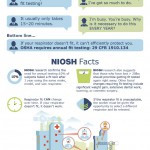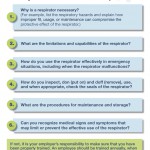N95 Day 2016: Proper Use, Filtration, and Fit – The Three-Legged Stool of Respiratory Protection
Posted on by Dear N95 Day enthusiast – We want to thank you for joining us for another year of N95 respiratory protection information celebration. We know – today is 9/6, not 9/5. But we hope that many of you enjoyed the Labor Day holiday yesterday and are rested and ready for our annual N95 Day holiday today! NIOSH established this observance because N95 respirators are so important to the health and safety of workers in so many different industries. Much of the information this year focuses on the big three factors that contribute to effective respiratory protection: proper respirator use, filtration, and fit.
Dear N95 Day enthusiast – We want to thank you for joining us for another year of N95 respiratory protection information celebration. We know – today is 9/6, not 9/5. But we hope that many of you enjoyed the Labor Day holiday yesterday and are rested and ready for our annual N95 Day holiday today! NIOSH established this observance because N95 respirators are so important to the health and safety of workers in so many different industries. Much of the information this year focuses on the big three factors that contribute to effective respiratory protection: proper respirator use, filtration, and fit.
These three factors are the three structural legs of respiratory protection. The analogy of the three-legged stool has been applied in popular literature for decades to describe retirement benefits, healthcare, and business models, among other topics. We’re flexing our metaphorical muscles and adding respiratory protection to that list because the analogy just works so darn well. You don’t have to be an engineer to know that a three-legged stool requires legs of equal length – otherwise you get that annoying, unstable wobble.
To a respirator user whose workplace requires the N95 level of protection, the three components of proper respiratory protection are even more important. The protection a user receives from a properly worn N95 filtering facepiece respirator or elastomeric respirator with an N95 cartridge (for the purpose of this blog, we will combine these two into the general term “N95 respirator”) can have a direct effect on that user’s health and safety. To be effective, respiratory protection requires three main things: (1) the respirator has to be put on correctly and worn during the exposure; (2) the respirator needs to capture 95% or more of the particles that pass through the filter (where the 95 in N95 comes from); and (3) the respirator must fit the user’s face to minimize the risk that particles will simply bypass the filter and get into the breathing zone through gaps between the user’s skin and the respirator seal. If any one of these falls short, the wearer could be in store for bigger problems than an annoying wobble.
One fancy way of estimating exposure reduction considers two factors: wear-time and protection. (See references below.) Wear-time is the amount of time the respirator is worn properly when the hazard is present, while protection is a function of respirator fit and particle filtration.
Proper Use
Although it may seem obvious, it is worth repeating that if the respirator is not worn or used properly during exposure, it will not keep the wearer from coming into contact with hazardous particles. Proper respirator use has been an on-going theme of N95 Day and the NIOSH Science Blogs. For those in the healthcare industry, we are introducing our new Hospital Respiratory Protection Resources webpage to help you quickly find needed resources. Studies have shown that workers are more likely to comply with respirator requirements and best practices when they understand how and why the devices work. NIOSH has been developing tools to assist hospital respiratory protection program managers perform this important function. The new website will serve as a hub for these types of NIOSH resources and make it easier for hospital respiratory protection program managers and interested users to find both NIOSH-generated information that supports OSHA’s 1910.134 respiratory protection standard, as well as more approachable education tools, including infographics, fact sheets, and training videos.
We’ve now established the first leg of our stool, but you don’t get to sit on it quite yet…
Filtration
As outlined in 42 Code of Federal Regulations Part 84, NIOSH applies test conditions that represent near “worst case” scenarios when testing N95 respirators submitted for approval. This ensures that filters in NIOSH-approved respirators will collect different workplace aerosols (including emerging hazards such as airborne infectious organisms and engineered nanoparticles) with high efficiency. While the science of particle filtration has been known for decades, we still get questions regularly through our PPE hotline and CDC-info from users, policy-makers, and respiratory protection program managers about whether NIOSH-approved N95 respirators will filter out specific hazards. To help explain the concepts of particle filtration and address these questions, NIOSH developed an educational video titled “A Particle is a Particle.”
Filtration makes up the second leg of the stool, but it’s still not quite safe (balanced?)…
Fit
Respirator fit can be a complex subject. OSHA’s 1910.134 respiratory protection standard requires respirator fit testing initially and annually thereafter. Within the last two decades, NIOSH has published influential research demonstrating why initial respirator fit testing is so important and providing additional scientific justification in support of annual fit testing. Our webinar this year is titled “The Science behind Respirator Fit Testing in the Workplace: Past, Present, and Future.” This webinar will help you answer two questions… Why do we have to fit test? And why every year?! For more information about the webinar as well as other N95 Day resources, see the N95 Day webpage. If you missed the webinar, don’t worry. It will be posted online after the close of the event. (This article will be updated with the new link.)
With these three components in place, we now have a fully-functional, safe and stable, NIOSH-approved three-legged stool. (Metaphorically speaking, of course. We don’t “approve” furniture.)
We appreciate your participation in N95 Day, showing your dedication to occupational safety and health through following and sharing our social media on Twitter (@NIOSH, @NPPTL), Facebook, and Instagram (nioshusa). Please use today as an excuse to put aside the other distractions of your busy schedule and delve into our resources. Have a happy and safe N95 Day!
Additional Links to Explore
N95 2016 Infographics
 |
 |
Previous N95 Day Science Blogs
- 2012: Happy N95 Day! (aka, What is N95 Day?)
- 2013: A Guide to N95 Resources
- 2014: Respirator Preparedness – Where Technology Meets Good Practices
- 2015: The tools to build a culture of proper respiratory protection practices
Previous Science Blogs on N95 Respirator Use, Fit, and Filtration
- Reaching Towards a Healthier, Safer Workplace: NIOSH looks at healthcare worker familiarity with recommended respiratory protection practices
- N95 Respirators and Surgical Masks
- Respiratory Protection for Workers Handling Engineered Nanoparticles
- New NIOSH Study Supports the OSHA Annual Fit Testing Requirements for Filtering Facepiece Respirators
References
- Gosch ME, Shaffer RE, Eagan AE, Roberge RJ, Davey VJ, Radonovich LJ. B95: a new respirator for health care personnel. American journal of infection control. 2013 Dec 31;41(12):1224-30.
- Janssen L, Ettinger H, Graham S, Shaffer R, Zhuang Z. Commentary: the use of respirators to reduce inhalation of airborne biological agents. Journal of occupational and environmental hygiene. 2013 Aug 1;10(8):D97-103.
Jaclyn Krah, MA, is a Health Communications Specialist in the in the NIOSH National Personal Protective Technology Laboratory.
Ronald Shaffer, PhD is Chief of Technology Research Branch at NIOSH’s National Personal Protective Technology Laboratory.
Posted on by


